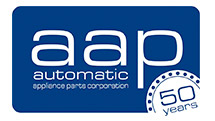How to Choose the Right Size Washer & Dryer for Your Lifestyle
You Are Here: Home > Automatic Appliance Parts Blog > How to Choose the Right Size Washer & Dryer for Your Lifestyle
*** Please be aware that Norridge is the only shipping facility. Inventory on-hand at all other branches is unavailable for immediate shipment. ***
When it comes to washers and dryers, there isn't a one-size-fits-all option. Different people will have different needs based on the size of their family, the size of their laundry area, and their washing needs. So how do you choose the right washer and dryer for your lifestyle? This helpful guide will go over the considerations you should keep in mind when you're shopping for a new washer and dryer so you can pick ones that will work for you.
Choosing a New Washer
When you're ready to purchase a new washer, you'll find a dizzying array of options available. Before you start shopping, it's a good idea to think about your current and future needs. To help you focus, keep the following factors in mind.
Top-Load vs. Front-Load
There are two types of washers to choose from: top-load washers and front-load washers. Both options have advantages and disadvantages that you'll want to keep in mind when shopping.
Front-load washers are typically more energy-efficient than top-load washers. This is because front-load washers use a tumbling method instead of an agitator to clean clothes. While this requires less water, it does mean front-load machines have a longer wash cycle. Plus, some people believe the tumbling method doesn't get clothes as clean as an agitator. It's also important to note that you often can't pause a wash cycle in a front-load washer to add an extra piece of clothing. Additionally, they're typically more expensive than top-load washers.
While top-load washers are more on the budget-friendly side, they also aren't as energy-efficient, which might end up costing you more money in the long run. However, many people find top-load washers more comfortable to use because they don't require as much bending down and reaching as front-load machines. Additionally, top-load washers can come both with and without agitators, which makes it easier for you to choose the style you like.
High-Efficiency Washers
Whether you decide to go with a top-load or front-load washer, if you're interested in conserving energy, you'll want to look for a high-efficiency machine. While all front-load washers are high-efficiency, only top-load washers without agitators are high-efficiency models.
Even though high-efficiency washers have a larger capacity, they use about half the water as a traditional washer. Not only is this good for conservation, but it can also cut down on drying time. Since your clothes already come out of the washer a little drier to the touch, they have to spend less time in the dryer.
The Latest Features
Manufactures have been developing a variety of cutting-edge features for washing machines. Here are just a few of the latest advancements you might see on different models:
- Extra rinse cycle- Helps get rid of stubborn messes, pet hair, and detergent residue.
- Built-in sink- Good for soaking to help pre-treat stains and for washing small loads of delicate clothing.
- Automatic dispensers- Can hold a months' worth of detergent and release the right amount at the appropriate time during the wash.
- Mobile app- Lets you program a cycle and alert you when the cycle is complete.
Choosing a New Dryer
Just like washers, there are a variety of dryer options on the market. As you're shopping for your new dryer, these are the different factors you'll want to keep in mind.
Gas vs. Electric
Even though all dryers are front-load machines, you still have a decision to make when it comes to the dryer's energy source. Dryers can run on either gas or electric. Electric dryers typically require a 240-volt outlet, and gas dryers need a gas hookup and a 120-volt outlet. While both options tend to offer similar performance and drying times, electric dryers are still the more popular choice.
High-Efficiency Dryers
Dryers use an incredible amount of energy, so it's always a good idea to consider a high-efficiency machine. High-efficiency dryers try to keep drying times to a minimum by using a moisture sensor instead of a thermostat. Not only does this feature help you save energy, but it also preserves fabrics by keeping them in the dryer for a shorter amount of time and in less heat.
A moisture sensor works by detecting how wet your clothes are and adjusting the drying time accordingly. However, it's important to note that if you routinely dry smaller loads, your clothes might not touch the sensor often enough to work properly. In those instances, you're better off using a timed-dry cycle.
When Space Is an Issue
The typical washer and dryer are between 27 to 28 inches wide and 30 to 35 inches deep. If you have a small laundry area, you might not have the space to fit these machines. Fortunately, you do have other options: a compact washer and dryer or a stackable washer and dryer.
A compact washer and dryer are usually 24 inches wide, between 24 to 29 inches deep, and around 33 to 34 inches tall. They have a capacity of about 2.3 cubic feet, which equals around six bath towels. They usually stack with the washer on the bottom and the dryer on top.
If you like the stacking feature because space is limited, a compact washer and dryer isn't your only choice. You can also go with a stackable washer and dryer. These full-size machines have doors and control buttons on the front and the option of purchasing a stacking kit to install the dryer above the washer.
Taking Care of Your Washer and Dryer
Once you pick out your new washer and dryer, you want to enjoy them for as long as possible. When you get a new washer, remember to also purchase new washing machine hoses. Choose stainless steel instead of rubber to avoid potentially costly leaks. One of the most common issues with the dryer is that it's simply not drying clothes. Clogs or kinks in the exhaust line are the main cause, so make sure these are always clean.
If you need quality parts and accessories for your washer and dryer, contact Automatic Appliance Parts Corporation. We have one of the most comprehensive parts inventories in the country, and we're ready to serve your needs.

 Shopping Cart [empty]
Shopping Cart [empty]









